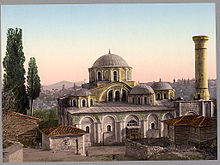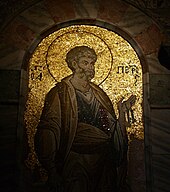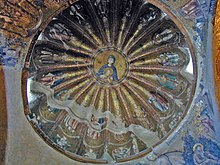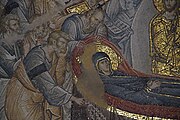
Hagia Sophia, officially the Hagia Sophia Grand Mosque, is a mosque and former church serving as a major cultural and historical site in Istanbul, Turkey. The last of three church buildings to be successively erected on the site by the Eastern Roman Empire, it was completed in 537 AD. The site was a Chalcedonian church from 360 AD to 1054, an Orthodox church following the Great Schism of 1054, and a Catholic church following the Fourth Crusade. It was reclaimed in 1261 and remained Eastern Orthodox until the fall of Constantinople in 1453. It served as a mosque until 1935, when it became a museum. In 2020, the site once again became a mosque.

A mosaic is a pattern or image made of small regular or irregular pieces of colored stone, glass or ceramic, held in place by plaster/mortar, and covering a surface. Mosaics are often used as floor and wall decoration, and were particularly popular in the Ancient Roman world.

Theodore Metochites was a Byzantine Greek statesman, author, gentleman philosopher, and patron of the arts. From c. 1305 to 1328 he held the position of personal adviser (mesazōn) to emperor Andronikos II Palaiologos.

Zeyrek Mosque or the Monastery of the Pantokrator, is a large mosque in Fazilet Sokağı in the Zeyrek district of Fatih in Istanbul, overlooking the Golden Horn. It is made up of two former Byzantine churches and a chapel joined together and represents the best example of Middle Byzantine architecture in Constantinople. After Hagia Sophia, it is the largest Byzantine religious edifice still standing in Istanbul.

Fenâri Îsâ Mosque, known in Byzantine times as the Lips Monastery, is a mosque in Istanbul, made of two former Eastern Orthodox churches.

The Pammakaristos Church, also known as the Church of Theotokos Pammakaristos, is one of the most famous Byzantine church buildings in Istanbul, Turkey, and was the last pre-Ottoman building to house the Ecumenical Patriarchate. Converted in 1591 into the Fethiye Mosque, it is today partly a museum housed in a side chapel or parekklesion. One of the most important examples of Constantinople's Palaiologan architecture, the mosque contains the largest quantity of Byzantine mosaics in Istanbul after the Hagia Sophia and The Chora.

Kalenderhane Mosque is a former Eastern Orthodox church in Istanbul, converted into a mosque by the Ottomans. With high probability the church was originally dedicated to the Theotokos Kyriotissa. The building is sometimes referred to as Kalender Haneh Jamissi and St. Mary Diaconissa. This building represents one among the few extant examples of a Byzantine church with domed Greek cross plan.

Bodrum Mosque in Istanbul, Turkey, is a former Eastern Orthodox church converted into a mosque by the Ottomans. The church was known under the Greek name of Myrelaion.

The Eski Imaret Mosque is a former Byzantine church converted into a mosque by the Ottomans. The church has traditionally been identified as belonging to the Monastery of Christ Pantepoptes, meaning "Christ the all-seeing". It is the only documented 11th-century church in Istanbul which survives intact, and represents a key monument of middle Byzantine architecture. Despite that, it remains among the least studied buildings in the city.

Church-Mosque of Vefa is a former Eastern Orthodox church converted into a mosque by the Ottomans in Istanbul. The church was possibly dedicated to Hagios Theodoros, but this dedication is far from certain. The complex represents one of the most important examples of Comnenian and Palaiologan architecture of Constantinople.
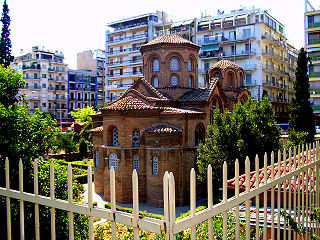
A cross-in-square or crossed-dome plan was the dominant architectural form of middle- and late-period Byzantine churches. It featured a square centre with an internal structure shaped like a cross, topped by a dome.

Koca Mustafa Pasha Mosque is a former Eastern Orthodox church converted into a mosque by the Ottomans, located in Istanbul, Turkey. The church, as the adjoining monastery, was dedicated to Saint Andrew of Crete, and was named Saint Andrew in Krisei or by-the-Judgment. Although heavily transformed during both the Byzantine and the Ottoman eras, it is one of the few extant churches in Istanbul whose foundation goes back to the sixth century.

Atik Mustafa Pasha Mosque is a former Eastern Orthodox church in Istanbul, converted into a mosque by the Ottomans. In Çember Sokak in the neighbourhood of Ayvansaray, in the district of Fatih, Istanbul, it lies just inside the walled city at a short distance from the Golden Horn, at the foot of the sixth hill of Constantinople.

A Parecclesion is a side mortuary chapel found in early Byzantine churches.

The Church of the Holy Apostles is a 14th-century Byzantine church in the northern Greek city of Thessaloniki. Because of its outstanding Byzantine mosaics and architecture, and its testimony to the importance of Thessaloniki in early and medieval Christianity, the church is inscribed on the UNESCO World Heritage List along with other Paleochristian and Byzantine monuments of Thessaloniki.
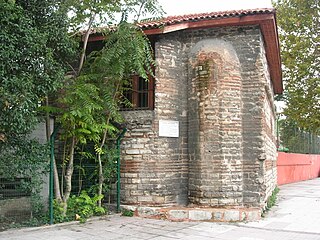
Manastır Mosque is a former Eastern Orthodox church converted into a mosque by the Ottomans. Neither archeological excavations nor medieval sources have made it possible to find a satisfactory answer as to its original dedication as a church. It is however possible that the small building was part of the Byzantine monastery dedicated to the Holy Martyrs Menodora, Metrodora, and Nymphodora, or an annex of the nunnery of Kyra Martha. The edifice is a minor example of Byzantine architecture in Constantinople, and is important for historical reasons.
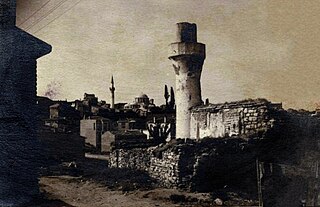
The Odalar Mosque was an Ottoman mosque in Istanbul. The building was originally a Byzantine-era Eastern Orthodox church of unknown dedication. In 1475, after the Fall of Constantinople (1453), it became a Roman Catholic church, dedicated to Saint Mary of Constantinople, until finally it was converted into a mosque by the Ottomans in 1640. The mosque was destroyed by fire in 1919, and since then has fallen into ruin. As of 2011, only some walls remain, hidden among modern buildings.
Toklu Dede Mosque, was an Ottoman mosque in Istanbul, Turkey. The building was originally a Byzantine Eastern Orthodox church of unknown dedication. It was almost completely destroyed in 1929.

The Church of Hagia Sophia or Holy Wisdom is a Byzantine church in the medieval town of Monemvasia, Peloponnese, Greece. It forms part of the wider archaeological site of Monemvasia. It was built on the upper town of Monemvasia, and was originally dedicated to Panagia Hodegetria. It is the most important monument of Monemvasia. The Venetians, who held Monemvasia for some time, used it as a Catholic church dedicated to Madonna, while during the Ottoman period it was converted into a mosque before being restored to Christian worship upon Greece's independence.

